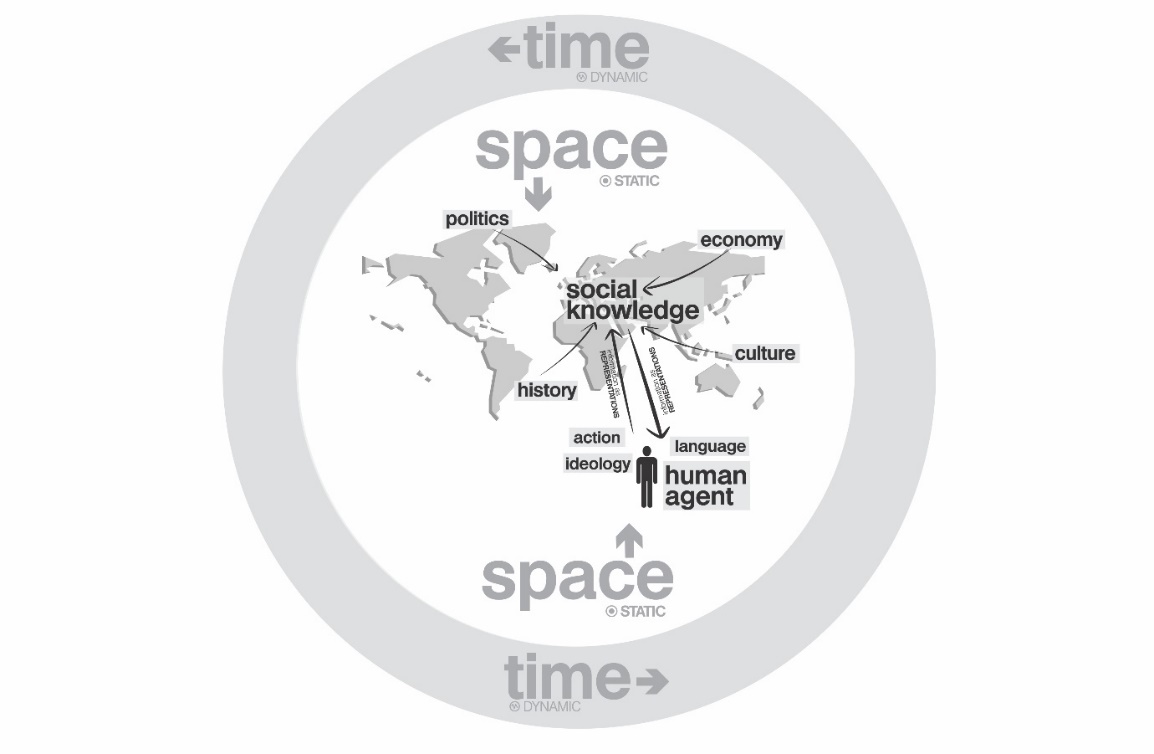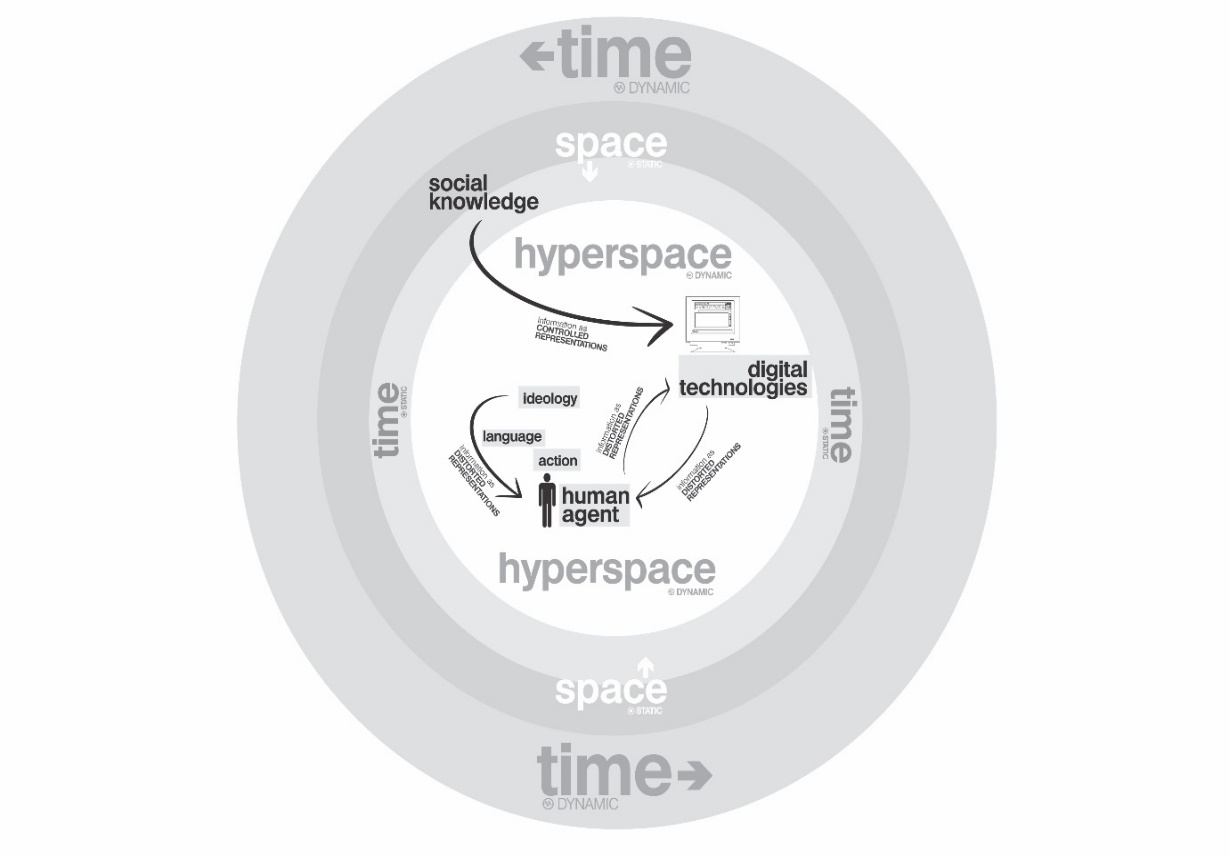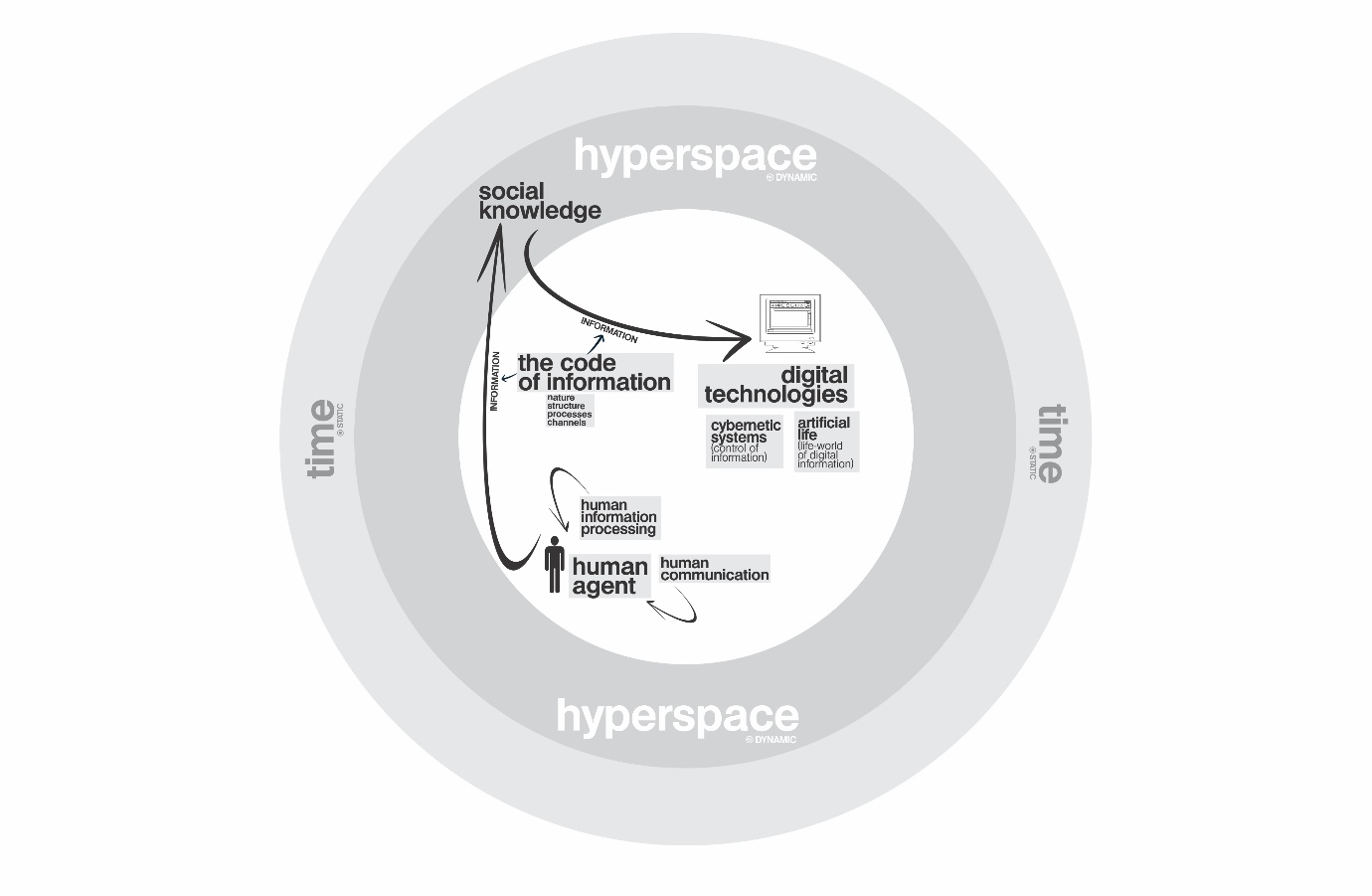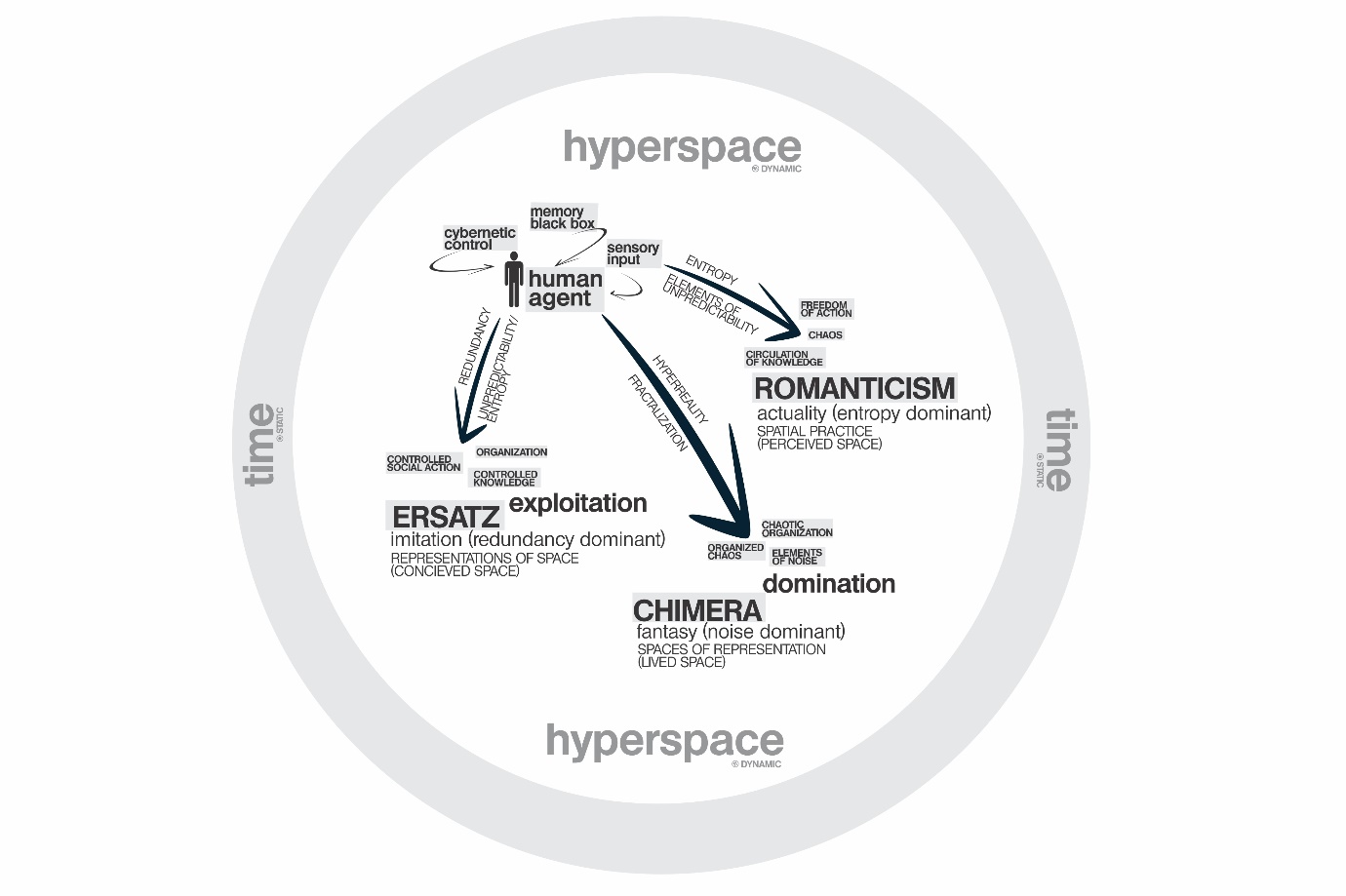Abstract
The paper examines and analyses the nature and content of information and knowledge in the era of advanced digitalization of learning. It is suggested that the information flow and the subsequent knowledge construction present multiple levels and dimensions of ‘reality’ which result in the ambiguity of what is registered as ‘real’ and/or ‘fake’ in the realm of human information processing. The analysis draws on the organization of the global system of information thesis along four inter-related hypotheses (‘,’ and, ‘). It expands on the notion of the digital reconstruction of hyper-reality in post-modern ICT learning environments adopting a Lefebvrian view of ‘.’ It stresses the need for fresh ways of thinking, unavoidably abstract and probabilistic and possibly paradoxical and controversial, to recognize and authenticate the repetitive and ambiguous nature of knowledge construction in digital learning. The paper concludes with the proposal of a series of theoretical approximations on the construction of knowledge in digital learning, which comprise an analytical model termed ‘.’
Keywords: Theory of knowledge, digital learning, digital technologies, infogramic analysis, digital implosion
Introduction
In the beginning of the 21st century, the contemporary world society finds itself in a global crisis of identity. The problem is information related. With the advances in applications of electronic communication and digital technologies, the pace of human social progress has accelerated infinitely. The world has come to find about each other too much too fast, too soon. This has led to extremes of favoured excitement or unrestricted disenchantment towards advanced (computer) technologies. Societies have always based their social organization on information, and have always tried to maintain and control the order of the predominant system of organization. Achieving this order has always been seen as a highly accepted constructive action, whereas chaos, anarchy and disorder have always been seen as negative and widely condemned. These later conditions are not necessarily the case, as digital transformation and communication operates and thrives on a dynamic interchange of ambiguity and instability. Once the importance of the organizational power of the system of information is recognized, registered and acknowledged, then a series of issues become critical in the construction and transformation of social knowledge and the global social order.
Findings
The Multi-Dimensionality and Ambiguity of Information
With the advance of digital technologies and the intrusion of unprecedented amounts of information in our daily informational diets, the global system of (all available) information, has come to organize, and in a different sense to disorganize, every aspect of social life and human consciousness. It is, therefore, suggested that the representational patterns of social organization are a reflection and a manifestation of the organization of the system of information; it is characterized by a structural multi-dimensionality of relations of meaning that results in ambiguous and questionable constructs of knowledge, consequently, challenging human logic and consciousness by generating an uncertainty of meaning of what constitutes ‘true’ and/o ‘real.’ In this framework, we need to seek for a closer understanding of the underlying code that defines the structure and organization of the system of information, and this I contend, can be realized by employing a theoretical framework of theoretical approximations. The model can be used for the analysis of the organization of the system of information, in a world dominated by the presence and use of information communication and digital technologies, and by an increasingly digitized human consciousness being integrated and adapted in such technologies.
Four inter-related hypotheses are suggested for the detailed analysis and contextualization of the ways in which the system of information is structured and organized. They refer to how information is being mediated, how knowledge is digitally constructed, the underlying code (systemic conditions and interactions) of the system of information, and a theoretical visualization of the native microcosm of informational and knowledge constructs (Andoniou, 2008).
The ‘information flow’ hypothesis (Figure 1) describes how the global flows of information are generated by discourses such as history, politics, economy and culture. These powerful discourses of representational information produce what we understand and define as social knowledge at various phases of human information processing. Language and images, take the form of informational representations which form belief systems and ideologies through a series of responses of social communication and action.


The ‘social knowledge’ hypothesis (Figure 2) refers to the role of ICTs and digital technologies in processing and transforming the flows of information into widely accepted social knowledge, prescribed identities, and selectively preferred social actions. It is suggested that the concept of social knowledge becomes problematic as it is potentially vulnerable to manipulation by those global communication media which produce, form, disseminate and legitimize it. In the digital space (hyperspace), humans and machines process and exchange information, converging to a state of fractalized distortion of the system of information.
The ‘code of information’ hypothesis (Figure 3) argues that digital technologies encode information flows either at structural level, communicative channels and processes, and this code affects the formation of societies and the knowledge they are defined by and by which they operate. This distinct code can be analyzed to reveal powerful and dominant discourses. Systems of social knowledge can present similarities and analogies (isomorphies) which can be traced back to the original flows of information. An analysis of the code of information will reveal the falsehood of the authenticity of ‘generic’ human information processing, and will also reveal those patterns of ‘external’ cybernetic interference that are responsible for challenging the validity and originality of knowledge in digital learning.
Finally, the ‘system of information’ hypothesis (Figure 4) contends that social life and knowledge that shapes and defines it, follow distinctive epochal organizational patterns that spread along space and time. The system of information can be characterized by a freedom of expression and void of any interreferences (the ‘era of Romanticism’), by attempts and intended actions of exploitation (the ‘epoch of Ersatz’), and by more distinct domination of external manipulation and distortion (the ‘age of Chimera’). These levels of spatial organization coexist at all times at various intensities that affect the construction and relations of meaning, consequently, the structure and organization of knowledge and the social domain itself.
The Spatial Architecture of Digital Age
Transnational and global media corporations have taken over the control and flow of the worldwide dominant system of information, and amidst the digital revolution, their aim has been the normalization of its indiscriminate and anarchic character. Advanced societies around the world, have been deluged with a surplus of media simulated and perplexed hyper-realities, at the same time the rest of the developing world is bombarded with a cocktail of confused meanings and indecision towards an uncertain future. The development of ICT and telecommunications networks have intensified the production, generation, regeneration, circulation and exploitation of the system of information in an endless vicious circle. Global capitalism is renewed in flexibility and the effects are evident in qualitative transformations and rearrangements of social structures and conversions and mutations of human experience. Human communication is being challenged and disturbed as technological development comes to commercialize and colonize the world of human representation and imagination. Human interaction and communicational practice with computer technologies form and recreate new social attitudes and modes of spatial thinking. The increasing flow and management of information reconstructs social knowledge and re-organizes social life (Ford, 2016; Lefebvre, 1991).


The Social Mechanics of the Digital Age
Distinct social discourses characteristically inform and affect human awareness and subjectivity about social reality and change. Their effects are embodied in the accumulated social human experience and knowledge. They are also evident of their organizational patterns of the system of information that embodies them and out of which they emerge. The mechanics of the organizational system that boosts the world, that of information, can be identified in notions of interactivity, networking and flexibility. It is these attributes that provide the structural and processual support for the world dominance of digital capitalism and media imperialism. Human experience and the construction of meaning are re-negotiated into new relations of meaning within the hyper-real socio-cultural environments they develop. These new relations of meaning reach every part of the world through the economic systematization of globalization, and result in regenerating a global culture and collective consciousness, which seems to unify and merge the world into a common landscape of experiences, still one that leaves, certain details of validity of the fundamental soci0o-cultural and economic differences and transformations, unresolved. Rationalization tendencies strive to compete and survive in a world that becomes more irrational with every step towards the future. This is a world where irrationality is taking over and replacing the meaning of rationality.
The ‘Postmodern-and-Beyond’
There is a cultural dominant in the world of digital communication and technologies, guided by a new kind of probabilistic logic that is credited to a transforming human awareness worldwide. This global transformation is manifested in the uneven progress and fate of cultural systems across the world. The intrusion of the cultural domain by computer communication and technologies has created a surplus of informational value and has led to the fatal acceptance of defeat. ‘,’ is the intensification of culturally dominant signifiers with the purpose of the maximization of consumerism and maintenance of digital capitalism globally. Cultural homogenization and normalization networks aim in securing these conditions of consumption, often in the form of vague and invalid ideologies. Human ideologies become programmable systems of information, contributing towards the digital cloning and mutation of a fabricated human consciousness. Their structural and architectural organization reflects patterns of systemic organization of information. With the increasing digital possibilities for manipulation and exploitation of the system of information, ideologies become confused, seeking refuge indiscriminately to whatever social configuration can still put up with their perplexing management.
Lost in Spacetime
The ‘ dominates the new cultural paradoxes and ambiguities of new forms of the postmodern world. New postmodern formations are an extension and continuation of historical, socio-economic and cultural discourse, they manifest and intensify traditional and dominant discourse configuration attributing to them a surplus of informational content and meanings. Space and time re-emerge in new relational form generated by the code of the system of information within digital communication settings. In the common and traditional sense of what constitutes the world, memories create our, a past comprised of practiced and lived experiences stored in our memory banks as potential transformations into future action programmes. Beyond the sphere of our imagination lies the, a calculated and desired projection of future targets and outcomes. The is nothing more than a momentary transitional illusion between the and the. It represents the line we draw to mark the end of the memory input and prior experience and the starting point that our projection of the future begins. In this sense, the hardly exists, which leaves only the as the only registered and acknowledged physical ‘’. In the landscapes of hyperspace though, these relations between space and time are transformed.,and all remain in an infinite existence, as time is slowed down to becoming static. The is rewritten and re-lived again and again in infinite alterations and modifications. The illusions of athat is infinitely and potentially prescribed and programmed, become lived ‘’ of the. As for the, this is intensified with added excitement, imagination, creativity, sociability, and so on, and lasts indefinitely, or as long as your predefined ‘’ allows you to. With the increasing intrusion and use of electronic communication and computer technologies, the time of ‘postmodernity-and-beyond’ is characterized by the gradual shift and replacement of our lived experience of the physical world, with these hyper-spatial relations: the is rewritten, theis realized in the, and the is enhanced and redesigned to accommodate everything else.
The Eclipse of Meaning
In order to cope with the emerging digital reconstruction of hyper-reality, alternative ways of thinking and logic are needed, to map and decode the code of information. Information lies at the core of organization and it comes in the form of systematically dispersed order or systematically organized chaos. Whatever the form, the organizational patterns of diverse subsystems of the system of information provide analogies and isomorphies the identification of which can provide an initial theoretical basis to develop analytical models of the code of information. The analysis of information as a system, and the analogic and isomorphic comparisons to other systems, which information consists the organizational element of, can reveal different aspects of the mechanics and dynamics of its structure and operation. The system of information, in the digital technologies landscape, is a diverse entity based on conditions of interrelation and interdependence, on principles of self-organization and differentiation, and on factors of unpredictably complex and chaotic non-linear iterations towards fractalization.
Digital Illusions
The code, the control and the communication of information are all important aspects of the organization of the system of information. Traditional information theory concepts and principles are not inadequate or insufficient, rather need to be reconsidered within the postmodern digital environments, and to be readjusted to the logic of the justification of digital construction of reality. The digitalization of the system of information makes it vulnerable to control and to programmability. The system of information is vulnerable to the weaknesses of human information processing but also to the exploitative tendencies and interests of external interference and disturbance. Regardless of the strength of our defences to these susceptibilities, one starting point of our response would be coming to a closer understanding of the ways in which the system of information organizes itself, and reflexively organizes everything else. The potential danger of digital cybernetic interference is matched by potential problems in the content and relationships of the communicated system of information. In any case, it is obvious that the construction of social knowledge, reality and the world itself, are dependent on the code of the system of information.
Infogramic Analysis Model
Computer and digital technologies are digitally constructing reality, or to put it in a rather more accurate way, they are digitally reconstructing hyper-reality. It is within the boundaries of hyperspace or cyberspace that this re-association and re-transformation of the system of information takes place (Lefebvre, 2003; Middleton, 2016; Piazzoni, 2018). It is the human fascination with these new emerging digital spatialities that recreates and legitimizes the conditions of generation of the organization of the system of information in every aspect of contemporary social activity. In this sense, the ‘infogramic analysis’ framework, regarding the organization of the system of information, can apply to describe a wide range of topics of human communication and social organization (Andoniou, 2008).
The code of the system of information is structured along simultaneous and interacting levels of organization, each one being characterized by varying degrees of intensification of information. At any point in the arrow of time, the system of information presents simultaneous and irregular phases of authentic, simulated and illusionary segments of information (‘datagrams’ and ‘infograms’ (Infograms are informational constructs characterized by diverse multi-dimensional organizational patterns, which in turn are expressed along spatial symmetries and structural non-linear curves. Depending on their source of their fundamental components (the result of interactional arrangements of datagrams or other infograms), infograms can be categorized as: (a) ‘’ infograms (), (b) ‘’ infograms (), and (c) ‘’ infograms () (Andoniou, 2008).)). The rationale of their particular logic of organization is dependent and is reflected in the organization of social life and the world societies.
In the era of digital communication and computer technologies, the system of information implodes (‘virtual implosion’ ('is defined as a process of a series of continuous, infinite loops of dynamic change, expressed in distinctive phase spaces, and repeated in alternating and interrelated iterative cycles. It is characterized by three phase spaces of fractal mutation: '' (deconstruction), '' (infection), and, (reconstruction) (Andoniou, 2008).)) towards a dynamic fractalization (‘fractal dynamics’ (The three phase spaces of the ‘ of the system of information to fractalization, are controlled and interconnected by five powerful micro-processes hereby collectively termed as': '' (destruction), '' (excitement), '' (transformation), '' (rebirth), and '' (lawlessness) (Andoniou, 2008).)). The system of information is reflexively organized by socio-cultural configurations and entities which provide the justification of the relations of meaning that are generated. These new relations of meaning undergo a gradual evolution process of deconstruction, differentiation and reconstruction. As a result, every logical justification and confirmation of what consists social reality in the postmodern world and beyond, is being broken apart and eliminated, intensified, transformed, restated and liberated from the traditional rules of human logic and social agreement.
In the world of digital technologies, the flow and content of the system of information endure a virtual implosion , which can be said to represent a reflection of the fractal fate of the relations of meaning in postmodern societies. The quest for social change and transformation is driven up by the catastrophe of non-conformity to the dominant ideology and status quo of digital capitalism. Societies are led to an
orgasmic state of intensities and extremes, promoted and marketed through media imperialism. The world is going through a metamorphosis of contrasting socio-cultural landscapes, splits into super-worlds of secure existence and futuristic technological progress, or into under-words characterized by constant instability and struggle for survival and of no visibly better future. New epigenetic social structures and forms emerge continually, only making contemporary life and the solutions to its problems more complicated.
Conclusion
We live in an anomic world, where we are programmed informationally. Whether we simply occupy forms of its structural architecture and or engage in the arena of social interactions, we are converted to the virtual representations of our imaginary and desired selves. Multiple dimensions (versions of originals and originals that never existed) of digital information generate and reconstruct ambiguous and questionable knowledge, confusing and redefining the line between reality and hyperreality. In this ocean of digital transformation and informational anomie, we find ourselves re-defined by our hyperreal topographical coordinates in a world we take for granted, yet a world of digital illusions. We become infogramic systems in a hyper-real world. As long as we understand, and as soon as we accept this, we can be at last, free.
References
1. Andoniou, C. (2008). Fractal fetishes: Essays on the Organization of the System of Information. VDM: Saarbrücken.
2. Ford, D. R. (2016). Education and the Production of Space: Political Pedagogy, Geography, and Urban Revolution. Routledge: Oxfordshire.
3. Lefebvre, H. (1991). The Production of Space. MA: Blackwell.
4. Lefebvre, H. (2003). The Urban Revolution. University of Minnesota Press: Minneapolis.
5. Middleton, S. (2016). Henri Lefebvre and Education: Space, history, theory. Routledge: Oxfordshire.
6. Piazzoni, M. F. (2018). The Real Fake: Authenticity and the Production of Space. Fordham University Press.
Copyright information

This work is licensed under a Creative Commons Attribution-NonCommercial-NoDerivatives 4.0 International License.
About this article
Publication Date
31 January 2022
Article Doi
eBook ISBN
978-1-80296-122-5
Publisher
European Publisher
Volume
123
Print ISBN (optional)
-
Edition Number
1st Edition
Pages
1-494
Subjects
Communication, Media, Disruptive Era, Digital Era, Media Technology
Cite this article as:
Andoniou, C. (2022). The Multi-Dimensionality and Ambiguity of Knowledge Construction and Digital Learning. In J. A. Wahab, H. Mustafa, & N. Ismail (Eds.), Rethinking Communication and Media Studies in the Disruptive Era, vol 123. European Proceedings of Social and Behavioural Sciences (pp. 352-360). European Publisher. https://doi.org/10.15405/epsbs.2022.01.02.30

